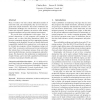Free Online Productivity Tools
i2Speak
i2Symbol
i2OCR
iTex2Img
iWeb2Print
iWeb2Shot
i2Type
iPdf2Split
iPdf2Merge
i2Bopomofo
i2Arabic
i2Style
i2Image
i2PDF
iLatex2Rtf
Sci2ools
EUROSYS
2009
ACM
2009
ACM
Isolating web programs in modern browser architectures
Many of today’s web sites contain substantial amounts of client-side code, and consequently, they act more like programs than simple documents. This creates robustness and performance challenges for web browsers. To give users a robust and responsive platform, the browser must identify program boundaries and provide isolation between them. We provide three contributions in this paper. First, we present abstractions of web programs and program inand we show that these abstractions clarify how browser components interact and how appropriate program boundaries can be identified. Second, we identify backwards compatibility tradeoffs that constrain how web content can be divided into programs without disrupting existing web sites. Third, we present a multi-process browser architecture that isolates these web program instances from each other, improving fault tolerance, resource management, and performance. We discuss how this architecture is implemented in Google Chrome, and we provide ...
EUROSYS 2009 | Keywords Web Browser | Multi-process Browser Architecture | System Software | Web Program Instances |
| Added | 10 Mar 2010 |
| Updated | 10 Mar 2010 |
| Type | Conference |
| Year | 2009 |
| Where | EUROSYS |
| Authors | Charles Reis, Steven D. Gribble |
Comments (0)

